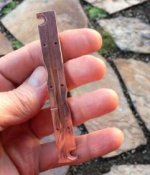Hello Laminar flow,
Copper and its alloys exhibit quite different thermal conductivity from alloy to alloy. Here is a simple link to some basics:
https://www.copper.org/publications/pub_list/pdf/a1360.pdf
Having spent my life designing instrumentation stuff, I have observed that many instrument SPECIFIERS have NO CLUE as to how some of the parameter choices that the people charged with building said instruments will have on the final performance of the device. Leaving the choice of material to you, with little specific guidance as to service temperature or the expectation as to the technical needs that the sensors material might have is a good path to unhappiness. My point is just that sometimes you have to badger the requester and explicitly query their needs. For example, if the sensor is to be used at cryogenic temperatures, Oxygen Free Copper is the only choice, although even there there may be huge subtleties known to those who deal with ultra-low temps.
Anyway, If you can nail down the temperature range the sensor will be used for, you can make a more informed choice. If you note the bottom of page 11 of the referenced document, above, the thermal and electrical properties of different alloys vary by a factor of 10. At ultralow temps, compared to OFC these alloys might look like insulators (I have not looked up the data, but it is easy to find). I was in fact so embarrassed I did look it up. There are a huge number of scholarly articles, but this one had some interesting data at lower temps:
Cryogenic Properties of Copper
If you find yourself lost in the maze of copper alloy designations, perhaps this will help a little:
https://www.copper.org/resources/properties/db/datasheets/all-alloys.pdf
Anyway, sharp tools and the right feed rates and surface speeds will get through most any copper alloy in good order.
Good luck!!
All the best,
Michael




